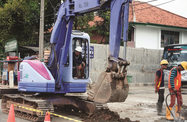A flurry of major infrastructure projects in Indonesia is set to boost the construction sector, although growth in the domestic building materials industry remains hamstrung by regional competition and government intervention in some cases.
Over the next five years the government aims to build 5,500km of railways, 2,600km of roads, 1,000km of toll roads, 49 dams and 24 seaports as well as to construct power plants with a combined capacity of 35,000 MW.
Improving Indonesia’s infrastructure was a key plank of President Joko Widodo’s election pledge last year to rejuvenate the economy with the move to scrap fuel subsidies and cap the diesel aid at the start of this year giving him access to Rp230trn ($18bn) of savings. The government is also keen to attract further investment from the private sector, through public private partnerships (PPPs).
As a result of the government push to bolster the country’s infrastructure, the value of new contracts is expected to rise by more than 70% this year to Rp45.8trn ($3.5bn) this year, according to two state-owned construction companies, Wijaya Karya and Adhi Karya. In tandem, the Ministry of Industry forecasts cement market growth to reach 10% this year, boosted by the government infrastructure projects. However, despite the positive indicators, the outlook for the building materials industry companies remains unclear.
Cement producers
Shares in the country’s two biggest cement producers, Holcim Indonesia and Semen Indonesia, jumped in the wake of the presidential election in July, in anticipation of the pledged infrastructure spending. However, the outlook for the companies shifted in January after the president instructed state-owned cement producers to lower their cement prices by around Rp3,000 ($0.23) per bag in an attempt to boost cement sales. Shares in the companies slumped, and analyst downgrades followed.
“The major risk for the cement industry is government intervention,” Arief Wana, a director at PT Ashmore Asset Management Indonesia, told Bloomberg in February. “You will see earnings cut and valuations re-rated.”
The industry is facing other challenges. Cement sales in January fell 2.9% year-on-year to 4.5m tonnes as heavy rain disrupted construction and weak commodity prices hit demand in the mining and agricultural industry. Subdued sales are likely to continue in February, according to Widodo Santoso, chairman of Indonesia Cement Association (ASI), prompting calls for the government to speed up infrastructure developments.
Competition in steel
Another key sector in the building materials market – steel – has seen limited growth in recent months, due to tough regional competition.
Officials admitted in February that a jump in imports of steel alloys had negatively affected the domestic industry as imports took a larger share of the market. Indonesian steel demand was about 15m tonnes in 2013, against a domestic production capacity of only 7m tonnes.
Industry insiders told OBG that Indonesia had the potential to become a Southeast Asian centre for steel construction materials, but more government assistance was needed.
“The interesting challenge for Indonesia is how to make the country a manufacturing hub in the region. There is fierce competition from countries like Vietnam, and the hurdles stemming from infrastructure gaps are a big limiting factor,” said Simon Linge, president director of steel producer BlueScope Steel Indonesia.
Linge added that for the building materials sector, Indonesia is exposed to a range of imported low end products, saying: “Imports from Vietnam and China put significant pressure on local producers pricing”.
Measures to protect domestic industry
While Indonesia has ample resources and benefits from a strategic location and overall manufacturing strength, it has some way to go to achieve self sufficiency in building materials with more government efforts needed to reduce raw material prices and improve electricity supply.
There are signs that Jakarta is listening to the industry. In February, the government imposed a safeguard duty on imported construction steel to curb the sharp rise in shipments to the local market.
According to the measure, set to last three years until January 2018, the products affected will be hit with a 28% safeguard duty, to be lowered to 26% and 18% respectively in the second and the third years. The duty should help lower imports of these steel parts, which have risen sharply in recent years. According to the Indonesian Trade Security Committee (KPPI) imports surged to more than 395,000 tonnes in 2013 from over 20,000 in 2010.
However, Linge said safeguards were not necessarily the answer to the growth problems experienced by the local industry. “These measures are only a distraction on how to really make Indonesia’s steel manufacturing more competitive. The government needs to take measures looking at the whole value chain in the local steel industry,” he said.
Indonesian Industry Ministry official Harjanto has also warned businesses not to take the safeguard as a chance to profit. “We need to introduce policies that not only protect the upstream cycle, but also the downstream industries. Safeguarding measures like this shouldn’t be taken for granted as an opportunity to raise prices, as that would obstruct other national projects,” he said.

